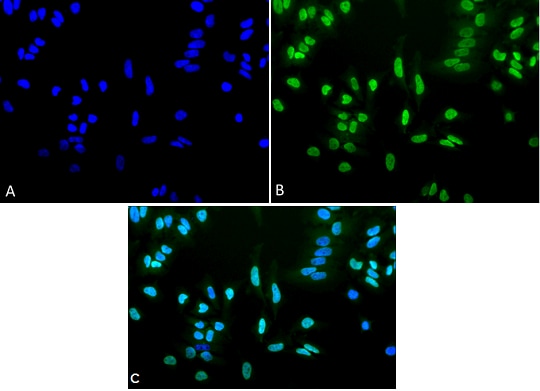Anti-acetyl Lysine antibody (ab80178)
Key features and details
- Rabbit polyclonal to acetyl Lysine
- Suitable for: WB, IP, ELISA, ICC/IF, IHC-P
- Reacts with: Species independent
- Isotype: IgG
Overview
-
Product name
Anti-acetyl Lysine antibody
See all acetyl Lysine primary antibodies -
Description
Rabbit polyclonal to acetyl Lysine -
Host species
Rabbit -
Tested applications
Suitable for: WB, IP, ELISA, ICC/IF, IHC-Pmore details -
Species reactivity
Reacts with: Species independent -
Immunogen
Acetylated KLH Conjugates
-
Positive control
- TSA treated mouse spleen cells.
-
General notes
The Life Science industry has been in the grips of a reproducibility crisis for a number of years. Abcam is leading the way in addressing the problem with our range of recombinant monoclonal antibodies and knockout edited cell lines for gold-standard validation.
One factor contributing to the crisis is the use of antibodies that are not suitable. This can lead to misleading results and the use of incorrect data informing project assumptions and direction. To help address this challenge, we have introduced an application and species grid on our primary antibody datasheets to make it easy to simplify identification of the right antibody for your needs.
Learn more here.
Properties
-
Form
Liquid -
Storage instructions
Shipped at 4°C. Store at -20°C. Stable for 12 months at -20°C. -
Storage buffer
Preservative: 0.1% Sodium azide
Constituent: Tris buffered saline -
 Concentration information loading...
Concentration information loading... -
Purity
Protein A purified -
Clonality
Polyclonal -
Isotype
IgG -
Research areas
Images
-
Immunocytochemistry/ Immunofluorescence analysis of Heat Shocked HeLa Cells labeling acetyl Lysine with ab80178 at 1/100 dilution. Cells were fixed with 2% Formaldehyde for 20 min at RT. DAPI (blue) nuclear counter stain at 1/40000 for 2 hours at RT. A FITC conjugated Goat Anti-Rabbit secondary antibody (green) was used at 1/200 dilution. Localization: Nucleus and Cytoplasm.
(A) DAPI (blue) nuclear stain. (B) Anti-acetyl Lysine antibody (ab80178) (C) Composite.
-
 Immunocytochemistry/ Immunofluorescence - Anti-acetyl Lysine antibody (ab80178) Image courtesy of Dr Natasha Snider by Abreview.ab80178 staining acetyl Lysine in human HepG2 cells by Immunocytochemistry/ Immunofluorescence. The cells were fixed in methanol and then blocked using 2% serum for 30 minutes at 25°C. Samples were then incubated with primary antibody at 1/150 for 1 hour at 25°C. The secondary antibody used was a goat anti-rabbit IgG conjugated to Alexa Fluor® 594 (red) used at a 1/1000 dilution.
Immunocytochemistry/ Immunofluorescence - Anti-acetyl Lysine antibody (ab80178) Image courtesy of Dr Natasha Snider by Abreview.ab80178 staining acetyl Lysine in human HepG2 cells by Immunocytochemistry/ Immunofluorescence. The cells were fixed in methanol and then blocked using 2% serum for 30 minutes at 25°C. Samples were then incubated with primary antibody at 1/150 for 1 hour at 25°C. The secondary antibody used was a goat anti-rabbit IgG conjugated to Alexa Fluor® 594 (red) used at a 1/1000 dilution. -
Immunocytochemistry/ Immunofluorescence analysis of Heat Shocked HeLa Cells labeling acetyl Lysine with ab80178 at 1/100 dilution. Cells were fixed with 2% Formaldehyde for 20 min at RT. DAPI (blue) nuclear counter stain at 1/40000 for 2 hours at RT. A R-PE conjugated Goat Anti-Rabbit secondary antibody (yellow) was used at 1/200 dilution. Localization: Nucleus and Cytoplasm.
(A) DAPI (blue) nuclear stain. (B) Anti-acetyl Lysine antibody (ab80178) (C) Composite.
-
Anti-acetyl Lysine antibody (ab80178) + Cell lysates prepared from TSA treated mouse spleen cells
Western blot analysis of Mouse Spleen lysates showing detection of Acetylated Lysine protein using Primary Antibody: Rabbit Anti-Acetyl Lysine Polyclonal Antibody (ab80178) at 1:1000.
-
 Immunohistochemistry (Formalin/PFA-fixed paraffin-embedded sections) - Anti-acetyl Lysine antibody (ab80178)ab80178 staining acetyl Lysine in human liver tissue by Immunohistochemistry (Formalin/PFA-fixed paraffin-embedded tissue sections). The sections were fixed in paraformaldehyde and subjected to heat-mediated antigen retrieval in citric buffer, pH 6.0 prior to blocking with 10% serum for 1 hour at 20°C. The primary antibody was diluted 1/100 and incubated with the sample for 12 hour at 4°C. An HRP-conjugated goat anti-rabbit polyclonal was used as the secondary antibody, diluted 1/200.
Immunohistochemistry (Formalin/PFA-fixed paraffin-embedded sections) - Anti-acetyl Lysine antibody (ab80178)ab80178 staining acetyl Lysine in human liver tissue by Immunohistochemistry (Formalin/PFA-fixed paraffin-embedded tissue sections). The sections were fixed in paraformaldehyde and subjected to heat-mediated antigen retrieval in citric buffer, pH 6.0 prior to blocking with 10% serum for 1 hour at 20°C. The primary antibody was diluted 1/100 and incubated with the sample for 12 hour at 4°C. An HRP-conjugated goat anti-rabbit polyclonal was used as the secondary antibody, diluted 1/200. -
 Immunocytochemistry/ Immunofluorescence - Anti-acetyl Lysine antibody (ab80178) Image courtesy of an anonymous Abreview.ab80178 staining acetyl Lysine (green) in the neuromuscular junction of fruit fly cells by Immunocytochemistry/ Immunofluorescence.
Immunocytochemistry/ Immunofluorescence - Anti-acetyl Lysine antibody (ab80178) Image courtesy of an anonymous Abreview.ab80178 staining acetyl Lysine (green) in the neuromuscular junction of fruit fly cells by Immunocytochemistry/ Immunofluorescence.
Cells were fixed in formaldehde, permeabilized using 0.4% Triton-X, blocked with 10% NGS for 1 hour at 20°C, then incubated with ab80178 at a 1/200 dilution for 16 hours at 4°C. The secondary used was an Alexa-Fluor 488 conjugated goat anti-rabbit polyclonal, used at a 1/1000 dilution.



















